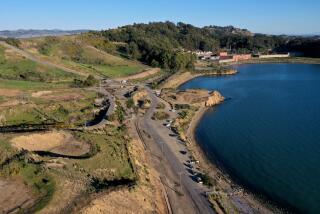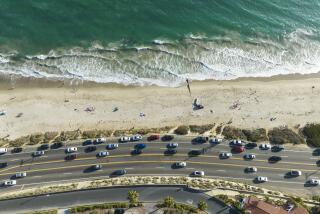Controversial Malibu Lagoon project to begin Friday
In a battle that has polarized the wealthy beach town of Malibu, activists are pledging to stand in the path of oncoming bulldozers when work begins this week on a controversial effort by the state to clean up a pollution-choked salt marsh that sits next to a world-renowned surf spot.
State contractors are set to begin fencing off Malibu Lagoon on Friday before draining the salt marsh and reshaping its shores and channels. Activists, who for years have fought a plan they believe is dangerously aggressive, say they will meet the bulldozers face-to-face and stage protests until the state backs off.
On one side is a well-organized alliance of surfers, environmental activists, Malibu locals and celebrities such as Pamela Anderson and Red Hot Chili Peppers singer Anthony Kiedis. They say the project is too heavy-handed, would destroy a lagoon they contend is already healthy and would flatten the waves at Surfrider Beach.
The activists have mounted a legal challenge that has delayed the project for a year, turned out in force at City Council meetings and held roadside protests with the slogans “Stop the Bulldozers” and “Save Malibu Lagoon.”
On the other side is the state of California, government scientists, a loose contingent of local supporters and prominent environmental groups saying that critics are ignoring years of science showing that the lagoon is sick and in need of radical surgery.
Backers have tried — mostly in vain — to convince the community that the $8-million restoration project will save the lagoon.
The idea to cleanse the lagoon’s sediment-clogged channels and oxygen-deprived waters was conceived more than a decade ago, and — initially — without much controversy.
The plan calls for workers to drain 12 acres of the wetland and scoop out more than 1,000 dump-truck loads of sediment. The banks will be reshaped and new vegetation planted, correcting a 1983 project that carved a restored wetland out of an estuary that had been filled with dirt to build baseball diamonds.
The four-month project, backers say, will create a viable ecosystem with water flowing in and out again; support more plants, birds and fish; and have no effect on surfing. They say it could potentially bring even cleaner water to Surfrider Beach, one of the most polluted in the state.
Opponents suffered what could be a final setback last week when a state appeals court denied their petition to halt the restoration, clearing the way for work to begin.
But they vowed to keep fighting to the last minute by appealing directly to state officials and running full-page newspaper advertisements.
“We still think this is a very bad project and needs to be rethought,” said Marcia Hanscom, who heads two groups that filed suit to halt the project.
Opposition to the project has snowballed over the last two years. It was a pressing issue in last month’s City Council election and a turning point for endorsements in a state Assembly race.
After Malibu withdrew its support for the restoration last month, Mayor Laura Rosenthal sent a letter asking Gov. Jerry Brown to place the restoration on permanent hold because the city’s concerns about water quality and the environment “have been ignored by the lead agencies, leading to mistrust and anger over this project.”
Brown responded with a statement supporting the science behind the restoration: “Without significant intervention, the Malibu Lagoon will continue in decline and is doomed to become a stagnant waterway, devoid of the kind of life that historically thrived here.”
The Los Angeles County Democratic Party joined the opposition last month, passing a resolution calling on the state to put the project on hold until more studies are completed on “whether the Lagoon destruction is necessary.”
State parks officials said the party relied on false and unsupported information. “The project will not destroy the lagoon,” Deputy Director Anthony Perez wrote in a May 1 letter.
Andy Lyon, a Malibu real estate agent and the most vocal of three surfers who ran for City Council opposing the restoration, calls the project the linchpin of a secret development scheme and accuses scientists and environmental groups of standing to benefit financially — claims supporters call outrageous and unfounded.
He and other opponents contend the grading of the wetland would ruin the flow of sand that forms the famous surf break’s perfect waves. Project supporters like the Surfrider Foundation, the international advocacy group founded in the 1980s by Malibu surfers, have rebutted that claim, saying the grading would have no effect on wave action.
Lyon said decades of surfing next to the lagoon tells him otherwise.
“They can drive their projects with their science or whatever they want to call it,” Lyon said, “but I’m in the water all the time.”
Suzanne Goode, a California State Parks environmental scientist, said such claims are typical of the “barrage of misinformation” the project has faced.
“We’ve tried to be on the record as much as possible to correct it,” she said, “but we’re not full-time PR people, we’re scientists and bureaucrats.”
Others say proponents left the door to criticism wide open because they failed to clearly communicate the need for the project.
“Ten years of science and research, and these groups with all their rabble-rousing are pulling the rug from under it,” said Randy Olson, a Malibu filmmaker and former marine biologist who is in favor of the project.
More to Read
Sign up for Essential California
The most important California stories and recommendations in your inbox every morning.
You may occasionally receive promotional content from the Los Angeles Times.











